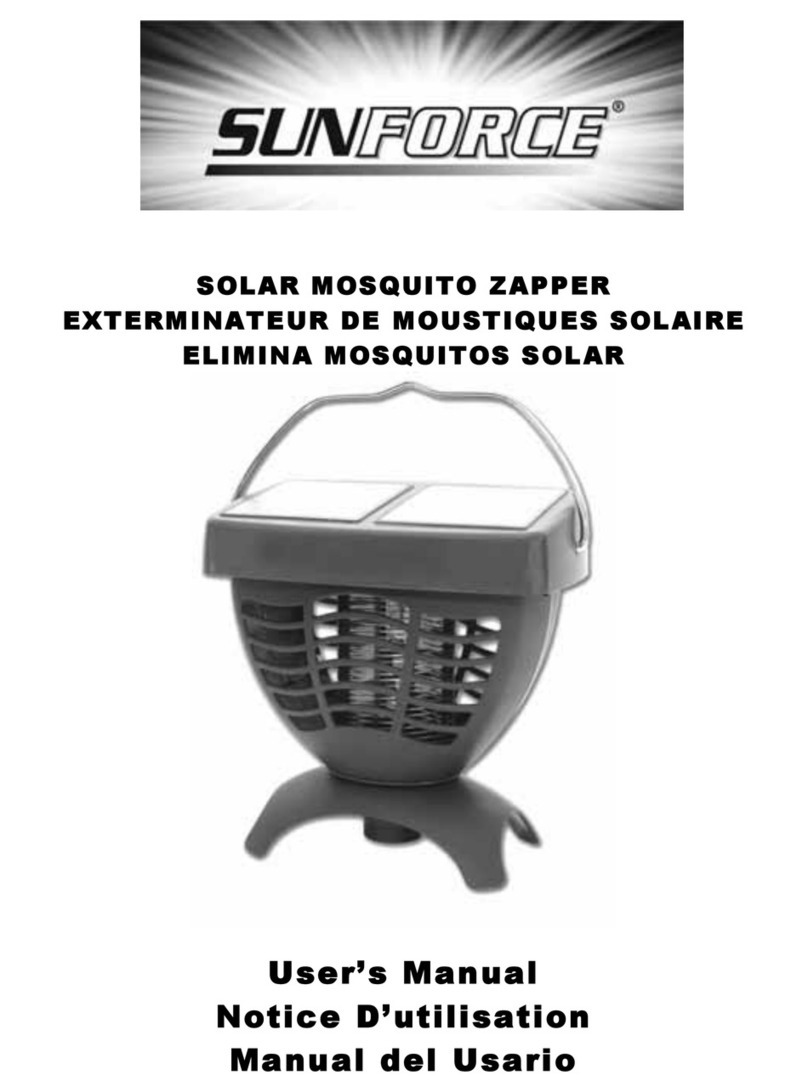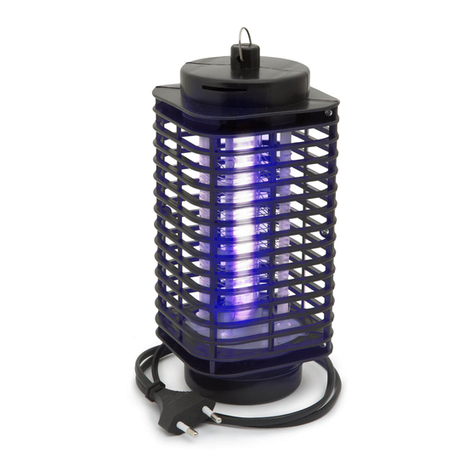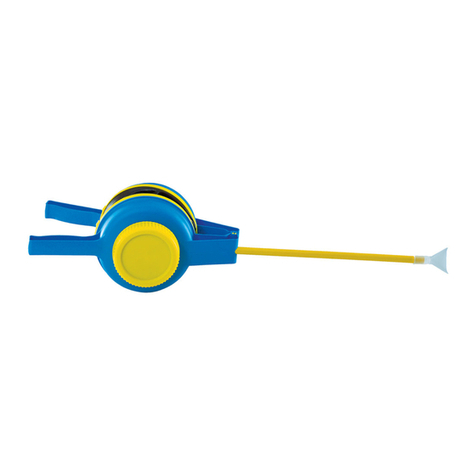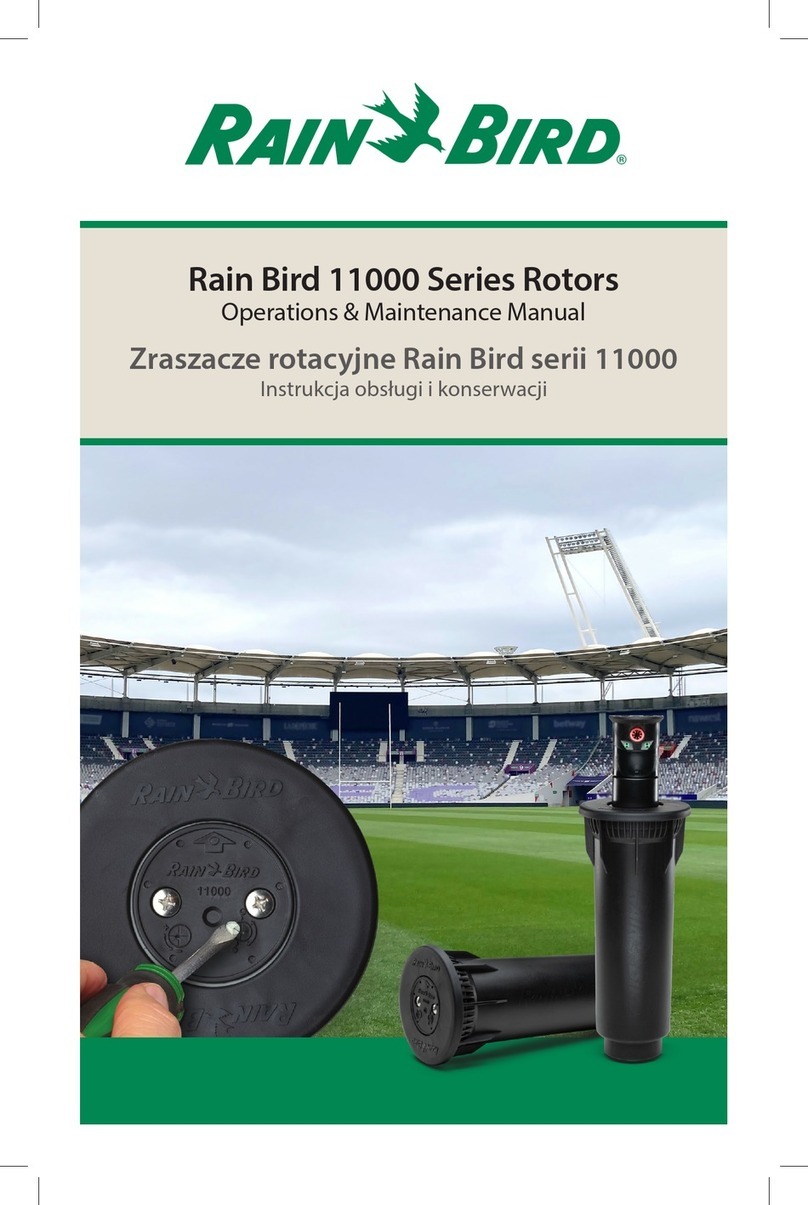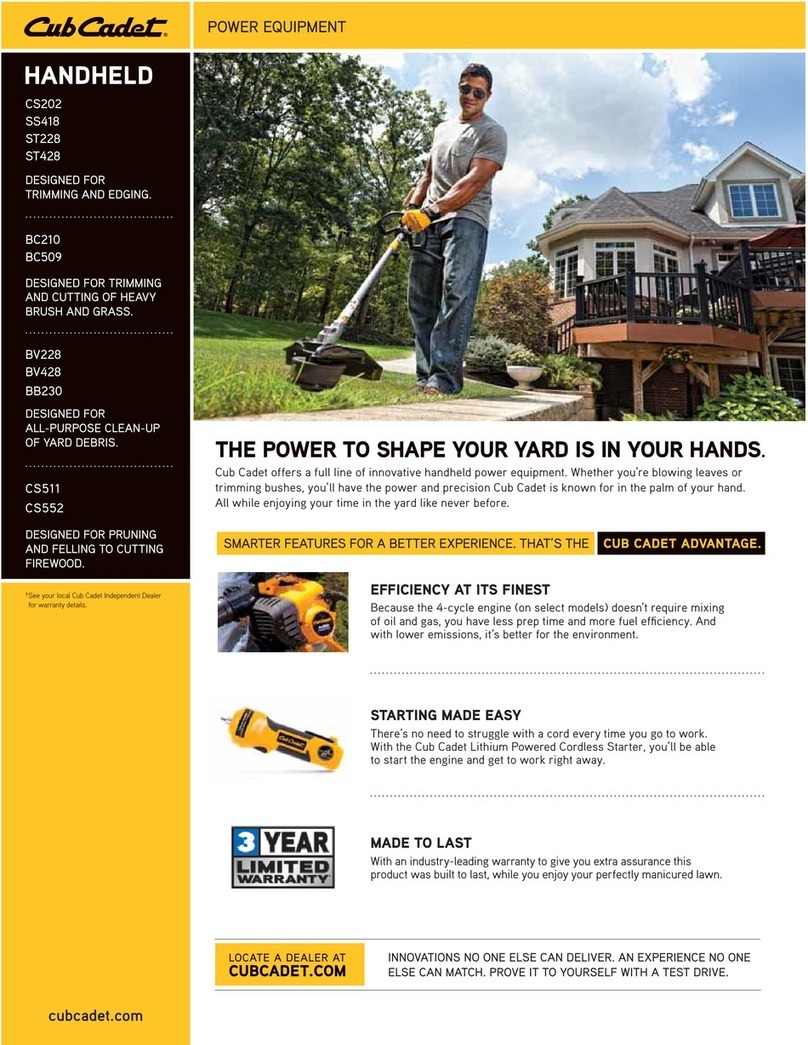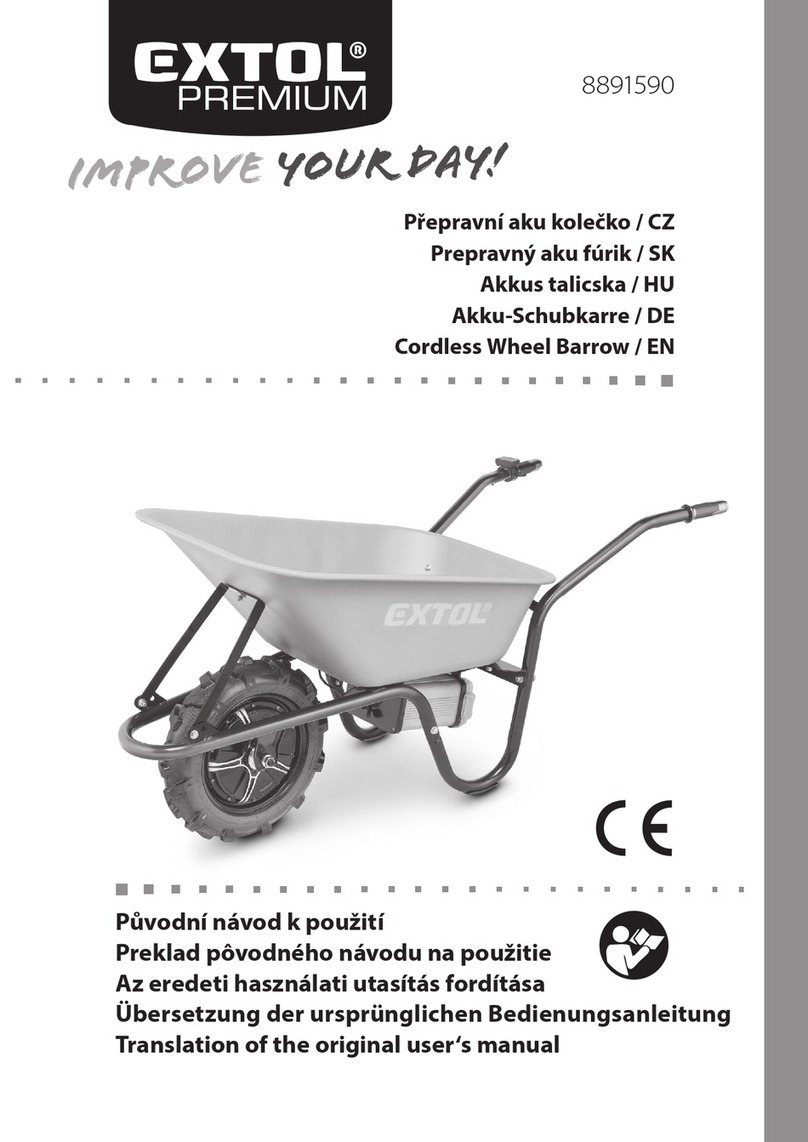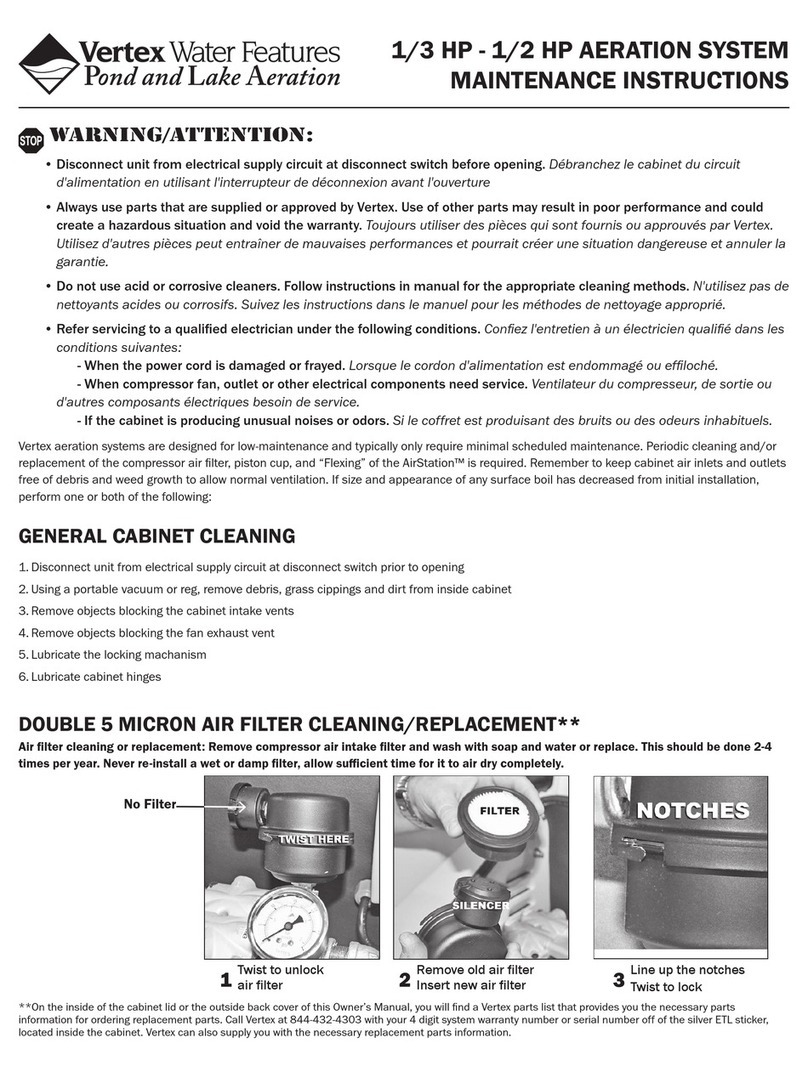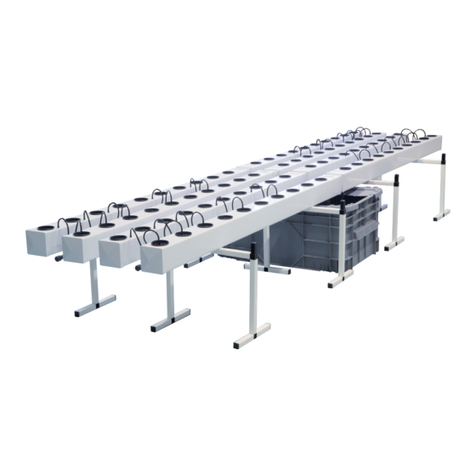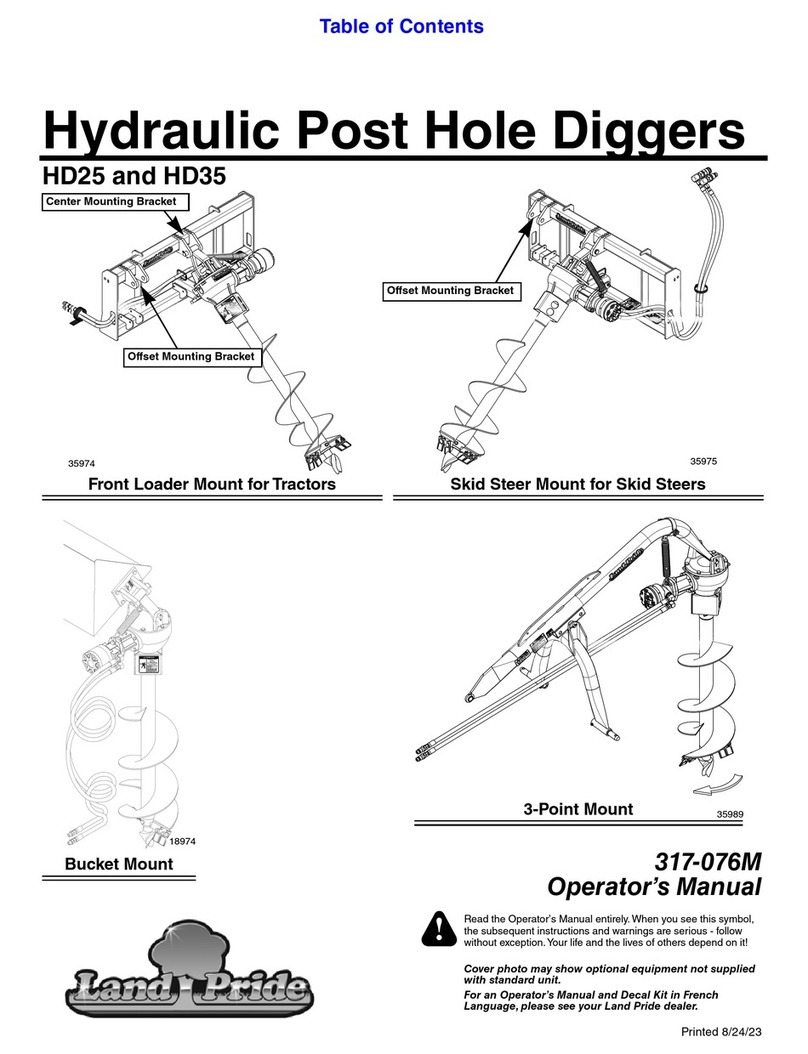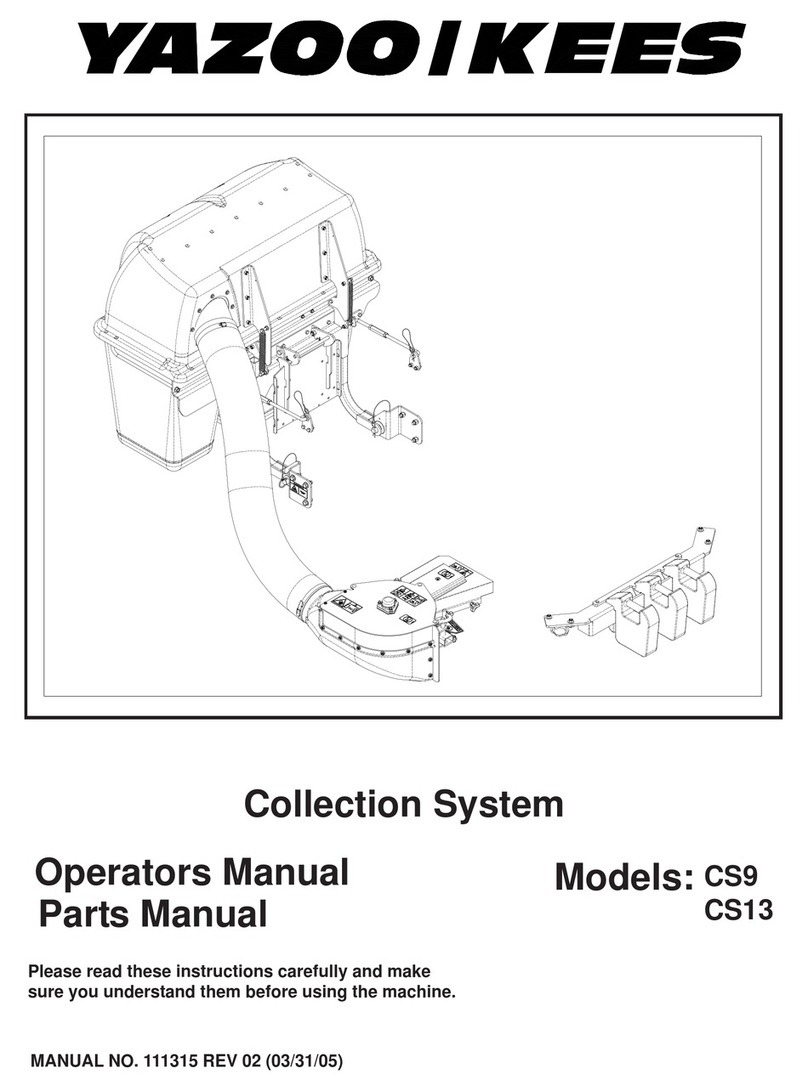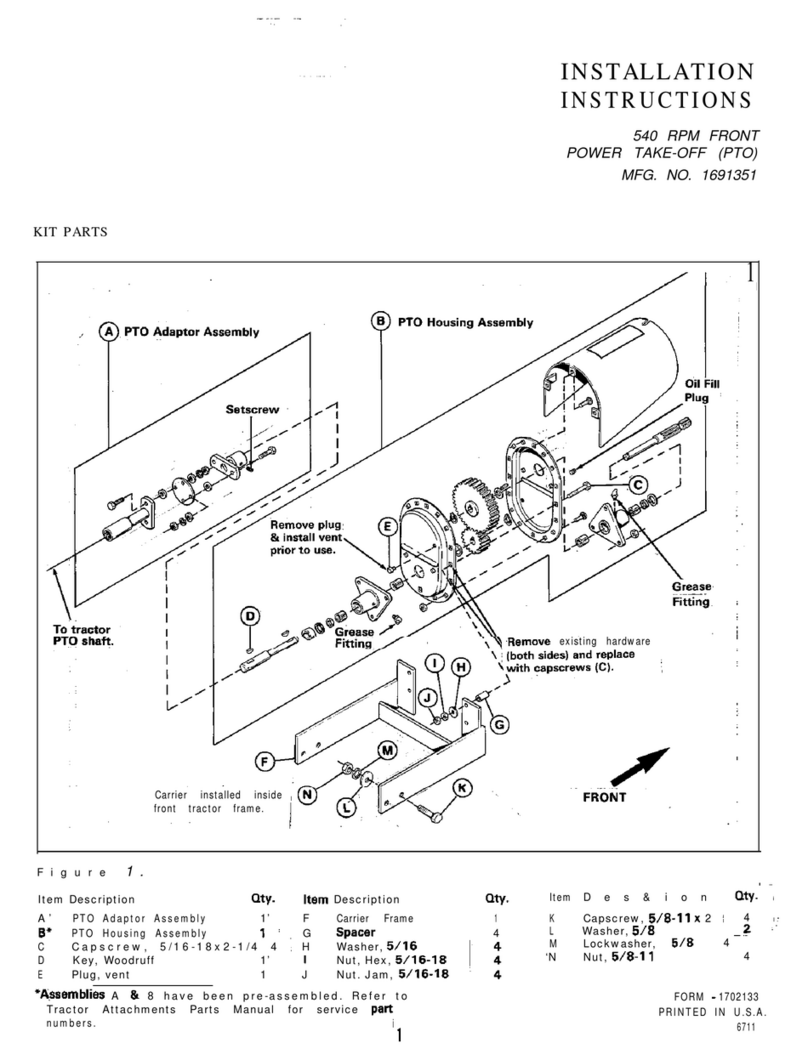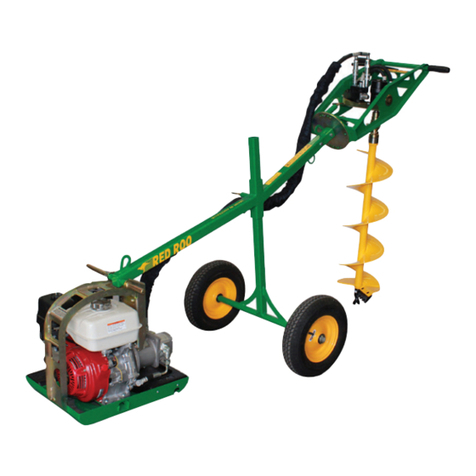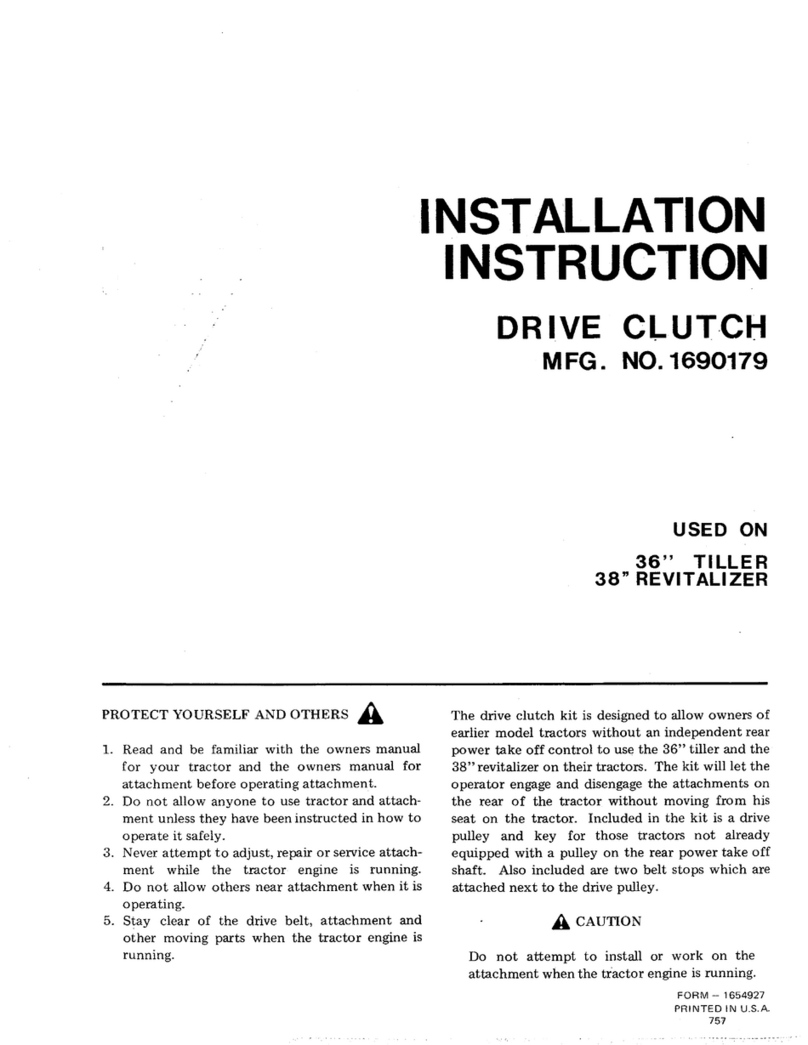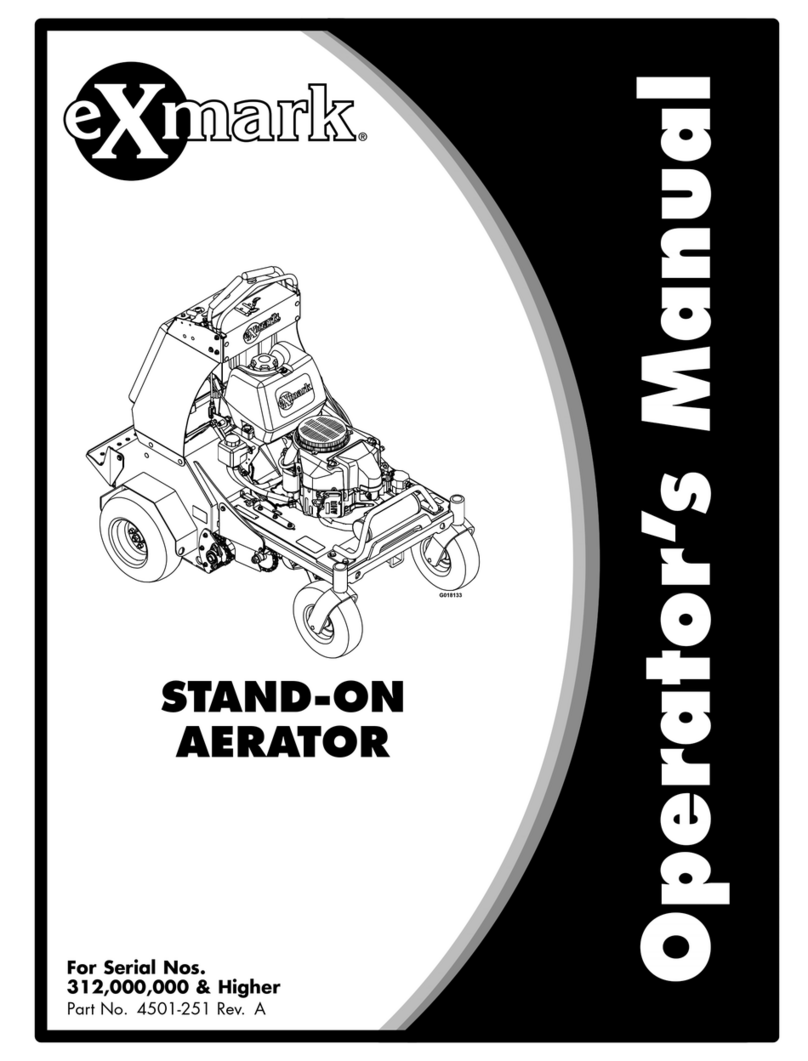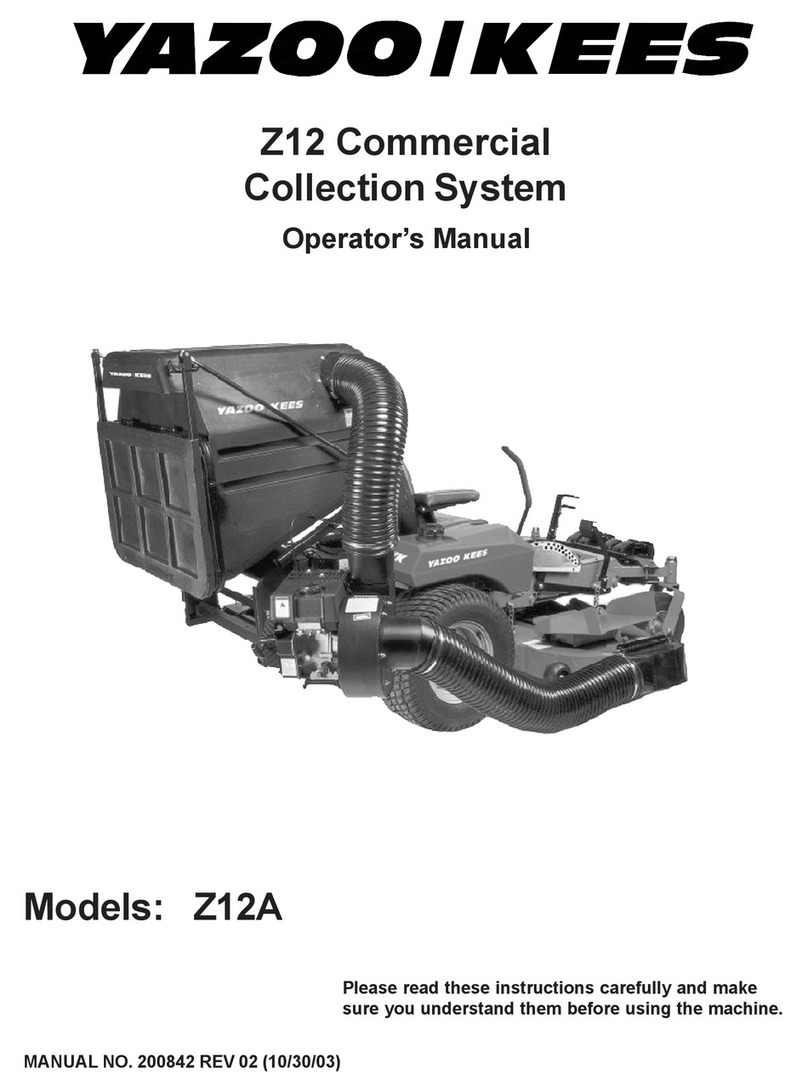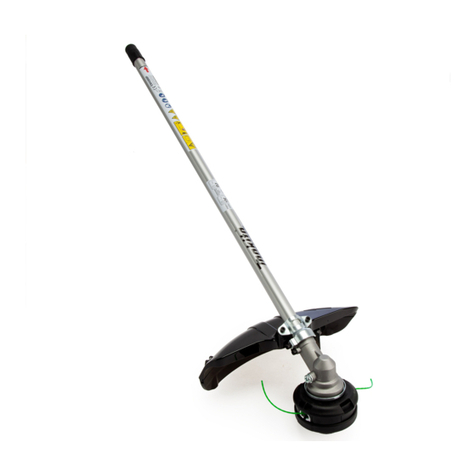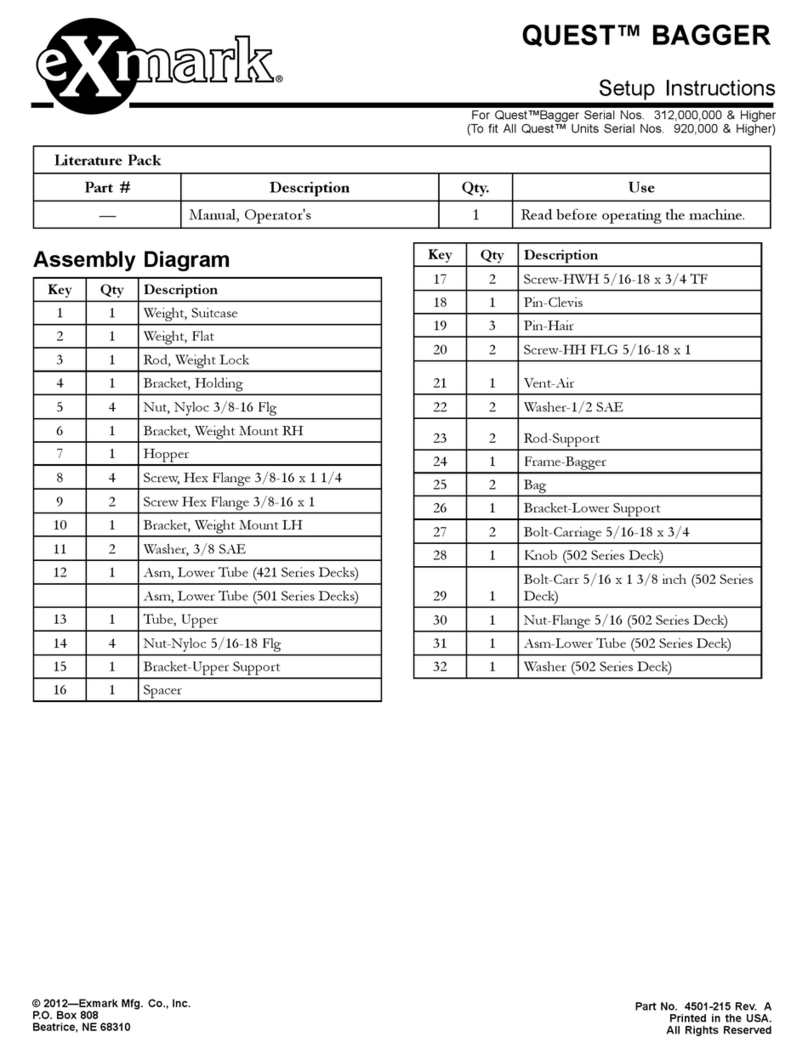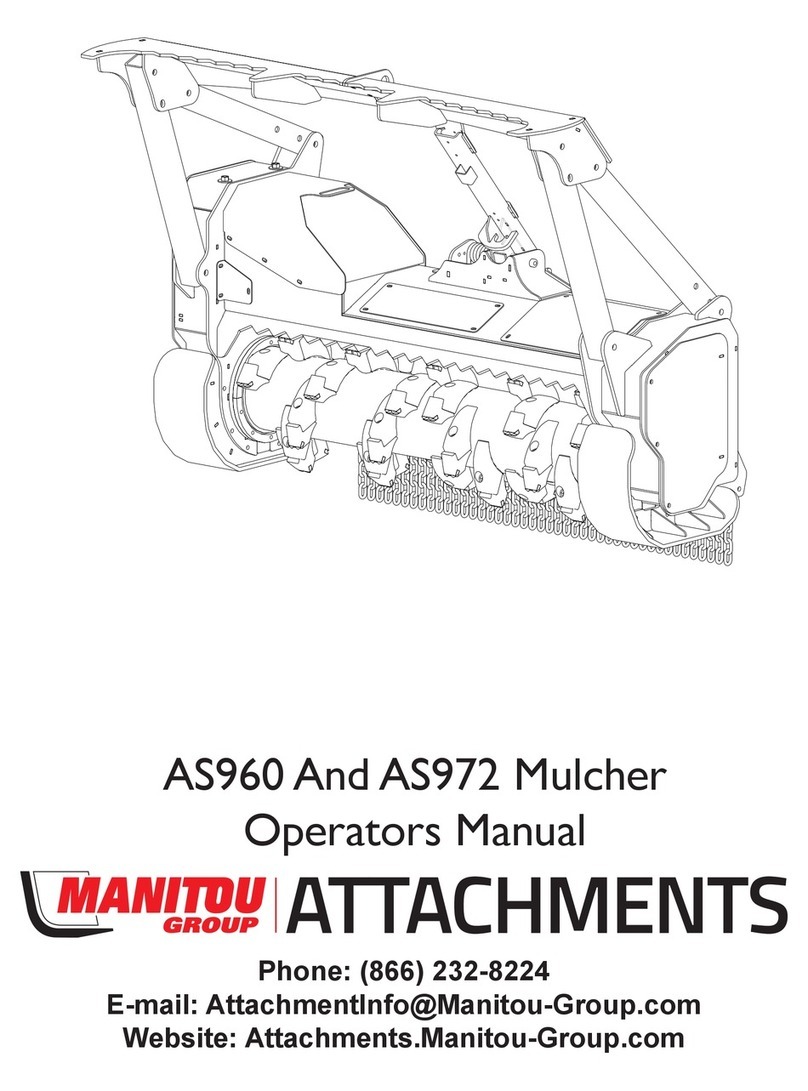
SAFETY INSTRUCTIONS FOR RH918 USERS
OPERATING
INSTRUCTIONS
USE COMMON SENSE
AND PLENTY OF IT
TRANSPORT
BEFORE USE
1) DO NOT allow any person operate the
rotary hoe without first reading and
understanding the safety instructions and
operating instructions.
2) NEVER allow children to operate the rotary hoe.
8) ALWAYS make certain the Tyne Control Lever is
set at neutral while loading and unloading the
rotary hoe, or moving to and away from working area.
9) NEVER run the machine in reverse while the tynes
are rotating. Always move the tyne control lever to
“OFF” before reversing the wheels.
11) DO NOT leave the machine unattended while the
engine is running.
12) DO NOT overspeed the engine or alter the governor
settings. Excessive speed is dangerous and will
shorten engine life.
13) NEVER operate the rotary hoe in an
enclosed area. Engine exhaust contains
carbon monoxide, an odourless and
tasteless poison.
14) STOP the engine and disconnect the
spark plug lead(s) and allow engine to
cool before inspecting or performing
maintenance on the rotary hoe.
15)
1)
REFUELLING
* Shut off the engine. DO NOT REFUEL
AN ENGINE WHILE OPERATING!
* Allow engine to cool. Minimum 5 minutes
* USE UNLEADED FUEL ONLY.
Use clean, fresh unleaded fuel.
* Do not mix oil with unleaded fuel.
* Do not over-fill fuel tank. Allow space
for fuel expansion.
10) NEVER operate the unit without the safety
guards in place and in working order. Keep
the unit well maintained and in good
working order.
4) ALWAYS use the rotary
hoe in a well lighted area.
7) NEVER operate the rotary hoe when fatigued.
ALWAYS BE ALERT! If you get tired while
operating the rotary hoe, take a break. If you have
any type of physical or mental condition that may
be aggravated by strenuous work, consult with
your physician before you operate this equipment.
NEVER operate the rotary hoe under the influence
of medication, alcohol or drugs.
6) DO NOT allow other persons near the
rotary hoe. It is up to the operator to keep
bystanders and animals a minimum of 6
5) ALWAYS operate the rotary
hoe on level ground only.
Police the area before rotary
hoeing. Remove any foreign objects in the digging
area - bricks, rocks, wire and sticks. Locate and mark
any sprinkler heads, water pipes, gas lines,
electrical and telephone cables or any other hazard
either below or above ground.
3) ALWAYS wear protective clothing when operating
the rotary hoe. This includes, but is not limited to;
safety glasses, loose fitting gloves, steel capped
boots and hearing protection. NEVER wear loose
fitting clothing or jewellery when operating the
rotary hoe. Keep all clothing away from moving
parts. Items could become caught in the machine,
resulting in injury.
KNOW THE CONTROLS AND HOW TO STOP
THE ROTARY HOE QUICKLY IN AN EMERGENCY.
metres (20’) away from the machine while in
operation.
ALWAYS KEEP YOUR HANDS,
FEET AND BODY AWAY FROM
THE DIGGING ZONE WHILE
ENGINE IS RUNNING.
* Do not smoke.
* Allow no naked flame or hot material in refuelling area.
* Use only approved fuel containers and funnels.
Remember, fuel is a potential hazard .
Be sure Tyne Control Lever is set to “Neutral”
while loading and unloading the rotary hoe
and when moving to or from jobsite.
Ensure that all grass and weeds have been cut
as low as possible.
2) If the rotary hoe is to be used in clay or hard
ground conditions, it is recommended to water
the area thoroughly and allow sufficient time
for earth to soften.
3) Police the area. Remove any
foreign objects from the area.
4) Identify and mark the location of sprinkler heads,
gas pipes, telephone cables etc.
“The Right Way to Rent”
You alone know the operational demands and
special conditions affecting the equipment in
your situation and therefore assume the
responsibility for developing, carrying out, and
enforcing the safety concepts which apply to your
own operation to effect the greatest safety for
yourself andthe people around you.
USE COMMON SENSE
AND PLENTY OF IT
1) DO NOT allow any person to operate
the rotary hoe without first reading
and understanding the safety
precautions and operating instructions. KNOW
THE CONTROLS AND HOW TO STOP THE
ROTARY HOE QUICKLY IN AN EMERGENCY.
2) NEVERallow children or untrained adults to
operate the rotary hoe.
3) ALWAYS wear
protective clothing
when operating the
rotary hoe. This includes, but is not limited to;
safety glasses, loose fitting gloves, steel
capped boots and hearing protection. NEVER
wear loose fitting clothing or jewellery when
operating the rotary hoe. Keep all clothing
away from moving parts. Items could become
caught in the machine, resulting in injury.
4) ALWAYS operate the rotary hoe in a well
lighted area.
5) ALWAYS make certain that all three control
clutches are in the "disengaged" position prior
to starting the engine.
6) ALWAYS operate rotary hoe on
level ground only. Police the
area before rotary hoeing.
Remove any foreign objects in the digging area
eg bricks, rocks, wire and sticks. Locate and
mark any sprinkler heads, water pipes, gas
lines, electrical and telephone cables or any
other hazard either below or above ground.
7) DO NOT allow other persons near the
rotary hoe. It is up to the operator to
keep bystanders and animals a
minimum of 6 metres (18ft) away from the
machine while in operation.
8) NEVER operate the rotary hoe when fatigued.
ALWAYS BE ALERT! If you get tired while
operating the rotary hoe, take a break. If you have
any type of physical or mental condition that may
be aggravated by strenuous work, consultwith
your physician before you operate this
equipment. NEVERoperate the rotary hoe under
the influence of medication, alcohol or drugs.
9) ALWAYS KEEP YOUR HANDS,
FEET AND BODY AWAY FROM
THE DIGGING AREA WHILE
ENGINE IS RUNNING.
10) NEVER operate the unit without the
safety guards in place and in working
order. Keep the unit well maintained
and in good working order
11) DO NOT leave the machine unattended while
the engine is running.
12) DO NOT overspeed the engine or alter the
governor settings. Excessive speed is
dangerous and will shorten engine life.
13) NEVER operate the rotary hoe in an
enclosed area. Engine exhaust
contains carbon monoxide, an
odourless and tasteless poison.
14) STOP the engine and disconnect the
spark plug lead(s) and allow engine
to cool before inspecting or
performing maintenance on the rotary hoe.
15) REFUELLING
* Shut off engine. DO NOT REFUEL
AN ENGINE WHILE OPERATING!
* Allow engine to cool. Minimum 5
minutes.
*USE UNLEADED FUEL ONLY.
Use clean, fresh unleaded fuel.
*Do not mix oil with unleaded fuel.
* Do not over-fill fuel tank. Allow space for fuel
expansion.
* Do not smoke.
* Allow no naked flame or hot material in
refuelling area.
* Use only approved fuel containers and
funnels. Remember, fuel is a potential
hazard.
SAFETY PRECAUTIONS FOR RH918 USERS
OPERATING
INSTRUCTIONS
TRANSPORT
The depth control bar is to be placed in its
lowest possible position. This will provide
sufficient clearance to prevent damage to the
rotor assembly.
BEFORE USE
1) Ensure that all grass and weeds have been
cut as low as possible.
2) If the rotary hoe is to be used in clay or hard
ground conditions, it is recommended to
water the area thoroughly and allow
sufficient time for the earth to soften.
3) Police the area. Remove any
foreign objects from the area.
4) Identify and mark the location
of sprinkler heads, gas pipes, telephone
cables, etc.
“STAY ALERT – DON’T GET HURT”
IS EVERYBODY’S BUSINESS
IS EVERYBODY’S BUSINESS
IS EVERYBODY’S BUSINESS
IS EVERYBODY’S BUSINESS
SAFETY INSTRUCTIONS FOR RH918 USERS
OPERATING
INSTRUCTIONS
USE COMMON SENSE
AND PLENTY OF IT
TRANSPORT
BEFORE USE
1) DO NOT allow any person operate the
rotary hoe without first reading and
understanding the safety instructions and
operating instructions.
2) NEVER allow children to operate the rotary hoe.
8) ALWAYS make certain the Tyne Control Lever is
set at neutral while loading and unloading the
rotary hoe, or moving to and away from working area.
9) NEVER run the machine in reverse while the tynes
are rotating. Always move the tyne control lever to
“OFF” before reversing the wheels.
11) DO NOT leave the machine unattended while the
engine is running.
12) DO NOT overspeed the engine or alter the governor
settings. Excessive speed is dangerous and will
shorten engine life.
13) NEVER operate the rotary hoe in an
enclosed area. Engine exhaust contains
carbon monoxide, an odourless and
tasteless poison.
14) STOP the engine and disconnect the
spark plug lead(s) and allow engine to
cool before inspecting or performing
maintenance on the rotary hoe.
15)
1)
REFUELLING
* Shut off the engine. DO NOT REFUEL
AN ENGINE WHILE OPERATING!
* Allow engine to cool. Minimum 5 minutes
* USE UNLEADED FUEL ONLY.
Use clean, fresh unleaded fuel.
* Do not mix oil with unleaded fuel.
* Do not over-fill fuel tank. Allow space
for fuel expansion.
10) NEVER operate the unit without the safety
guards in place and in working order. Keep
the unit well maintained and in good
working order.
4) ALWAYS use the rotary
hoe in a well lighted area.
7) NEVER operate the rotary hoe when fatigued.
ALWAYS BE ALERT! If you get tired while
operating the rotary hoe, take a break. If you have
any type of physical or mental condition that may
be aggravated by strenuous work, consult with
your physician before you operate this equipment.
NEVER operate the rotary hoe under the influence
of medication, alcohol or drugs.
6) DO NOT allow other persons near the
rotary hoe. It is up to the operator to keep
bystanders and animals a minimum of 6
5) ALWAYS operate the rotary
hoe on level ground only.
Police the area before rotary
hoeing. Remove any foreign objects in the digging
area - bricks, rocks, wire and sticks. Locate and mark
any sprinkler heads, water pipes, gas lines,
electrical and telephone cables or any other hazard
either below or above ground.
3) ALWAYS wear protective clothing when operating
the rotary hoe. This includes, but is not limited to;
safety glasses, loose fitting gloves, steel capped
boots and hearing protection. NEVER wear loose
fitting clothing or jewellery when operating the
rotary hoe. Keep all clothing away from moving
parts. Items could become caught in the machine,
resulting in injury.
KNOW THE CONTROLS AND HOW TO STOP
THE ROTARY HOE QUICKLY IN AN EMERGENCY.
metres (20’) away from the machine while in
operation.
ALWAYS KEEP YOUR HANDS,
FEET AND BODY AWAY FROM
THE DIGGING ZONE WHILE
ENGINE IS RUNNING.
* Do not smoke.
* Allow no naked flame or hot material in refuelling area.
* Use only approved fuel containers and funnels.
Remember, fuel is a potential hazard .
Be sure Tyne Control Lever is set to “Neutral”
while loading and unloading the rotary hoe
and when moving to or from jobsite.
Ensure that all grass and weeds have been cut
as low as possible.
2) If the rotary hoe is to be used in clay or hard
ground conditions, it is recommended to water
the area thoroughly and allow sufficient time
for earth to soften.
3) Police the area. Remove any
foreign objects from the area.
4) Identify and mark the location of sprinkler heads,
gas pipes, telephone cables etc.
“The Right Way to Rent”
You alone know the operational demands and
special conditions affecting the equipment in
your situation and therefore assume the
responsibility for developing, carrying out, and
enforcing the safety concepts which apply to your
own operation to effect the greatest safety for
yourself andthe people around you.
SAFETY PRECAUTIONS FOR CMS80 USERS
1) DO NOT allow any person to operate the
chipper mulcher shredder without rst
reading and understanding the safety
precautions and operating instructions.
KNOW THE CONTROLS AND HOW TO STOP
THE CHIPPER MULCHER SHREDDER IN CASE
OF AN EMERGENCY.
2) NEVER allow CHILDREN or UNTRAINED
ADULTS to operate the chipper mulcher shredder.
3) PPE (PERSONAL
PROTECTION
EqUIPMENT)
IS
MANDATORY
before operating this machine. ALWAYS
wear protective clothing when operating
the
chipper mulcher shredder
. This
includes, but not limited to; safety glasses, loose
tting gloves, steel capped boots and hearing
protection. Never wear loose tting clothing or
jewelry when operating the
chipper mulcher
shredder
. Keep all clothing away from moving
parts. Clothing could become caught in the
machine resulting in injury.
4) ALWAYS operate the chipper mulcher shredder in
a well-lighted area.
5)
NEVER operate the chipper mulcher
shredder on an angle that exceeds
15º degrees. Keep your work area
clear and free of debris.
6)
NEVER operate the
chipper mulcher shredder
when fatigued. AWAYS BE ALERT! If you get tired
while operating the
chipper mulcher shredder
take
a break. If you have any type of physical or mental
condition that may be aggravated by strenuous
work, consult with your physician before operating
this piece of equipment. NEVER operate the
chipper mulcher shredder
under the inuence of
medication, alcohol or drugs.
7)
SAFETY INSTRUCTIONS FOR RH918 USERS
OPERATING
INSTRUCTIONS
USE COMMON SENSE
AND PLENTY OF IT
TRANSPORT
BEFORE USE
1) DO NOT allow any person operate the
rotary hoe without first reading and
understanding the safety instructions and
operating instructions.
2) NEVER allow children to operate the rotary hoe.
8) ALWAYS make certain the Tyne Control Lever is
set at neutral while loading and unloading the
rotary hoe, or moving to and away from working area.
9) NEVER run the machine in reverse while the tynes
are rotating. Always move the tyne control lever to
“OFF” before reversing the wheels.
11) DO NOT leave the machine unattended while the
engine is running.
12) DO NOT overspeed the engine or alter the governor
settings. Excessive speed is dangerous and will
shorten engine life.
13) NEVER operate the rotary hoe in an
enclosed area. Engine exhaust contains
carbon monoxide, an odourless and
tasteless poison.
14) STOP the engine and disconnect the
spark plug lead(s) and allow engine to
cool before inspecting or performing
maintenance on the rotary hoe.
15)
1)
REFUELLING
* Shut off the engine. DO NOT REFUEL
AN ENGINE WHILE OPERATING!
* Allow engine to cool. Minimum 5 minutes
* USE UNLEADED FUEL ONLY.
Use clean, fresh unleaded fuel.
* Do not mix oil with unleaded fuel.
* Do not over-fill fuel tank. Allow space
for fuel expansion.
10) NEVER operate the unit without the safety
guards in place and in working order. Keep
the unit well maintained and in good
working order.
4) ALWAYS use the rotary
hoe in a well lighted area.
7) NEVER operate the rotary hoe when fatigued.
ALWAYS BE ALERT! If you get tired while
operating the rotary hoe, take a break. If you have
any type of physical or mental condition that may
be aggravated by strenuous work, consult with
your physician before you operate this equipment.
NEVER operate the rotary hoe under the influence
of medication, alcohol or drugs.
6) DO NOT allow other persons near the
rotary hoe. It is up to the operator to keep
bystanders and animals a minimum of 6
5) ALWAYS operate the rotary
hoe on level ground only.
Police the area before rotary
hoeing. Remove any foreign objects in the digging
area - bricks, rocks, wire and sticks. Locate and mark
any sprinkler heads, water pipes, gas lines,
electrical and telephone cables or any other hazard
either below or above ground.
3) ALWAYS wear protective clothing when operating
the rotary hoe. This includes, but is not limited to;
safety glasses, loose fitting gloves, steel capped
boots and hearing protection. NEVER wear loose
fitting clothing or jewellery when operating the
rotary hoe. Keep all clothing away from moving
parts. Items could become caught in the machine,
resulting in injury.
KNOW THE CONTROLS AND HOW TO STOP
THE ROTARY HOE QUICKLY IN AN EMERGENCY.
metres (20’) away from the machine while in
operation.
ALWAYS KEEP YOUR HANDS,
FEET AND BODY AWAY FROM
THE DIGGING ZONE WHILE
ENGINE IS RUNNING.
* Do not smoke.
* Allow no naked flame or hot material in refuelling area.
* Use only approved fuel containers and funnels.
Remember, fuel is a potential hazard .
Be sure Tyne Control Lever is set to “Neutral”
while loading and unloading the rotary hoe
and when moving to or from jobsite.
Ensure that all grass and weeds have been cut
as low as possible.
2) If the rotary hoe is to be used in clay or hard
ground conditions, it is recommended to water
the area thoroughly and allow sufficient time
for earth to soften.
3) Police the area. Remove any
foreign objects from the area.
4) Identify and mark the location of sprinkler heads,
gas pipes, telephone cables etc.
“The Right Way to Rent”
You alone know the operational demands and
special conditions affecting the equipment in
your situation and therefore assume the
responsibility for developing, carrying out, and
enforcing the safety concepts which apply to your
own operation to effect the greatest safety for
yourself andthe people around you.
DO NOT allow other adults, children or
animals near the chipper mulcher
shredder. IT IS THE RESPONSIBILITY
OF THE OPERATOR to keep bystanders and
animals a minimum of 6 metres (18ft) away from
the chipper mulcher shredder while in operation.
USE COMMON SENSE AND
PLENTY OF IT
OPERATOR MUST BE TRAINED
MAXIMUM ANGLE
OF OPERATION
DO NOT EXCEED
15º ANGLE
USE COMMON SENSE
AND PLENTY OF IT
SAFETY INSTRUCTIONS FOR HT912USERS
INSTRUCTIONS
DO NOT allow any person to operate the
hydraulic trencher without first reading and
understanding the safety instructions and
NEVER allow children to operate the hydraulic trencher.
ALWAYS use hydraulic trencher in a well lighted area.
ALWAYS make certain that all control clutches are in
the “disengaged” position prior to starting the engine.
The safety clutch lever/Operator Presence Control on
the left handlebar is for operator protection. DO NOT
tape down or otherwise bypass this Safety Device.
NEVER wear loose fitting clothing or jewellery when
operating the hydraulic trencher. Keep all clothing
away from moving parts. Item could become
caught in the machine, resulting in injury.
ALWAYS wear protective
clothing when operating
the hydraulic trencher.
This includes, but is not limited to, safety glasses, hard hat
loose fitting gloves, steel capped boots and hearing protection.
operating instructions. KNOW THE CONTROLS AND
HOW TO STOP THE HYDRAULIC TRENCHER QUICKLY
IN AN EMERGENCY.
1)
2)
3)
4)
Police the area before trenching. Remove any foreign
objects in the digging area eg bricks, rocks, wire and
sticks. Locate and mark any sprinkler heads, water
pipes, gas lines, electrical and telephone cables or any
other hazard either below or above ground.
5)
DO NOT leave the machine unattended while the engine
is running. DO NOT park on incline or park
perpendicular to slope. DO NOT freewheel down incline.
7)
DO NOT overspeed the engine or alter the governor
settings. Excessive speed is dangerous and will
shorten engine life
8)
NEVER operate the hydraulic trencher when fatigued.
ALWAYS BE ALERT! If you get tired while operating
the hydraulic trencher, take a break. If you have any
type of physical or mental condition that may be
aggravated by strenuous work, consult with your
physician before you operate this equipment. NEVER
operate the hydraulic trencher under the influence of
medication, alcohol or drugs.
9)
NEVER operate the unit without the safety
guards in place and in working order. Keep
the unit well maintained and in good working order
Remove the hydraulic trencher from its
trailer. Use caution.
Police the area. Remove any
foreign objects from the area.
Identify and mark the location of sprinkler heads,
gas pipes, telephone cables, etc.
IGNITION: Must be in “ON” position to start. “OFF”
to stop.
ENGINE: Throttle cable controls engine speed.
Operate at full throttle (all the way forward).
WHEEL DRIVE CONTROL LEVER: Controls wheel
speed forward or reverse after clutch lever is engaged.
DIGGING BOOM CONTROL LEVER: Raises and lowers
the digging boom.
DIGGING CHAIN CONTROL LEVER: must be in “ON”
position BEFORE clutch lever is depressed in order
to start chain in motion. Chain moves in a forward
direction after clutch lever is engaged.
SAFETY CLUTCH LEVER/OPERATOR PRESENCE
CONTROL: (At left handle grip) Activates WHEEL
DRIVE and DIGGING CHAIN controls when depressed.
Stops all motion when released.
FORWARD/REVERSE DIGGING CHAIN CONTROL
LEVER: Allows manual operation of chain in forward
or reverse rotation to dislodge objects or dig difficult
terrain. (This control can be used with the clutch lever
released.) To reverse chain, DIGGING CHAIN control
must be in “OFF” position.
Familiarize yourself with the hydraulic
trencher and its controls.
10)
1)
1)
2)
1)
Free Wheel Hub Feature - Operation:
Pull one free wheeling pin slightly, using the split
ring. Rotate the pin until the 3mm (1/8”) diameter roll
pin aligns with the slot in the mounting plate. Allow
the pin to slide through the slot. Repeat for the other
wheel. Roll the trencher until each pin drops into a
hole in the hub. The wheel hubs are now locked.
Reverse the procedure to unlock the wheels.
2)
DO NOT allow other persons near the hydraulic
trencher. It is up to the operator to keep
bystanders and animals a minimum of 6 metres
(20ft) away from the machine while in operation.
12)
NEVER operate the hydraulic trencher in an
enclosed area. Engine exhaust contains carbon
monoxide, an odourless and tasteless poison.
13)
WARNING: Hydraulic oil is under extreme
pressure and can get under skin and burn
or poison. Check for leaks with cardboard.
14)
STOP the engine and disconnect the spark
plug lead(s) and allow engine to cool before
inspecting or performing maintenance on
the hydraulic trencher.
15)
REFUELLING
* Shut off engine. DO NOT REFUEL AN ENGINE
WHILE OPERATING!
* Allow engine to cool. Minimum 5 minutes
* Do not smoke. *Allow no naked flame
or hot material in refuelling area.
* Use only approved fuel containers and funnels.
Remember, fuel is a potential hazard.
* Do not over-fill fuel tank. Allow space for
fuel expansion.
* USE UNLEADED FUEL ONLY. Use clean,
fresh unleaded fuel.
* Do not mix oil with unleaded fuel.
16)
ALWAYS KEEP YOUR HANDS, FEET AND BODY
AWAY FROM THE DIGGING CHAIN AND OTHER
MOVING PARTS WHILE ENGINE IS RUNNING.
11)
ALWAYS operate
hydraulic trencher
on level ground only.
6) MAXIMUM
ANGLE OF
OPERATION
DO NOT EXCEED 15ºANGLE
BEFORE USE
OPERATION
TRANSPORT
SAFETY INSTRUCTIONS FOR RH918 USERS
OPERATING
INSTRUCTIONS
USE COMMON SENSE
AND PLENTY OF IT
TRANSPORT
BEFORE USE
1) DO NOT allow any person operate the
rotary hoe without first reading and
understanding the safety instructions and
operating instructions.
2) NEVER allow children to operate the rotary hoe.
8) ALWAYS make certain the Tyne Control Lever is
set at neutral while loading and unloading the
rotary hoe, or moving to and away from working area.
9) NEVER run the machine in reverse while the tynes
are rotating. Always move the tyne control lever to
“OFF” before reversing the wheels.
11) DO NOT leave the machine unattended while the
engine is running.
12) DO NOT overspeed the engine or alter the governor
settings. Excessive speed is dangerous and will
shorten engine life.
13) NEVER operate the rotary hoe in an
enclosed area. Engine exhaust contains
carbon monoxide, an odourless and
tasteless poison.
14) STOP the engine and disconnect the
spark plug lead(s) and allow engine to
cool before inspecting or performing
maintenance on the rotary hoe.
15)
1)
REFUELLING
* Shut off the engine. DO NOT REFUEL
AN ENGINE WHILE OPERATING!
* Allow engine to cool. Minimum 5 minutes
* USE UNLEADED FUEL ONLY.
Use clean, fresh unleaded fuel.
* Do not mix oil with unleaded fuel.
* Do not over-fill fuel tank. Allow space
for fuel expansion.
10) NEVER operate the unit without the safety
guards in place and in working order. Keep
the unit well maintained and in good
working order.
4) ALWAYS use the rotary
hoe in a well lighted area.
7) NEVER operate the rotary hoe when fatigued.
ALWAYS BE ALERT! If you get tired while
operating the rotary hoe, take a break. If you have
any type of physical or mental condition that may
be aggravated by strenuous work, consult with
your physician before you operate this equipment.
NEVER operate the rotary hoe under the influence
of medication, alcohol or drugs.
6) DO NOT allow other persons near the
rotary hoe. It is up to the operator to keep
bystanders and animals a minimum of 6
5) ALWAYS operate the rotary
hoe on level ground only.
Police the area before rotary
hoeing. Remove any foreign objects in the digging
area - bricks, rocks, wire and sticks. Locate and mark
any sprinkler heads, water pipes, gas lines,
electrical and telephone cables or any other hazard
either below or above ground.
3) ALWAYS wear protective clothing when operating
the rotary hoe. This includes, but is not limited to;
safety glasses, loose fitting gloves, steel capped
boots and hearing protection. NEVER wear loose
fitting clothing or jewellery when operating the
rotary hoe. Keep all clothing away from moving
parts. Items could become caught in the machine,
resulting in injury.
KNOW THE CONTROLS AND HOW TO STOP
THE ROTARY HOE QUICKLY IN AN EMERGENCY.
metres (20’) away from the machine while in
operation.
ALWAYS KEEP YOUR HANDS,
FEET AND BODY AWAY FROM
THE DIGGING ZONE WHILE
ENGINE IS RUNNING.
* Do not smoke.
* Allow no naked flame or hot material in refuelling area.
* Use only approved fuel containers and funnels.
Remember, fuel is a potential hazard .
Be sure Tyne Control Lever is set to “Neutral”
while loading and unloading the rotary hoe
and when moving to or from jobsite.
Ensure that all grass and weeds have been cut
as low as possible.
2) If the rotary hoe is to be used in clay or hard
ground conditions, it is recommended to water
the area thoroughly and allow sufficient time
for earth to soften.
3) Police the area. Remove any
foreign objects from the area.
4) Identify and mark the location of sprinkler heads,
gas pipes, telephone cables etc.
“The Right Way to Rent”
You alone know the operational demands and
special conditions affecting the equipment in
your situation and therefore assume the
responsibility for developing, carrying out, and
enforcing the safety concepts which apply to your
own operation to effect the greatest safety for
yourself andthe people around you.
SAFETY INSTRUCTIONS FOR RH918 USERS
OPERATING
INSTRUCTIONS
USE COMMON SENSE
AND PLENTY OF IT
TRANSPORT
BEFORE USE
1) DO NOT allow any person operate the
rotary hoe without first reading and
understanding the safety instructions and
operating instructions.
2) NEVER allow children to operate the rotary hoe.
8) ALWAYS make certain the Tyne Control Lever is
set at neutral while loading and unloading the
rotary hoe, or moving to and away from working area.
9) NEVER run the machine in reverse while the tynes
are rotating. Always move the tyne control lever to
“OFF” before reversing the wheels.
11) DO NOT leave the machine unattended while the
engine is running.
12) DO NOT overspeed the engine or alter the governor
settings. Excessive speed is dangerous and will
shorten engine life.
13) NEVER operate the rotary hoe in an
enclosed area. Engine exhaust contains
carbon monoxide, an odourless and
tasteless poison.
14) STOP the engine and disconnect the
spark plug lead(s) and allow engine to
cool before inspecting or performing
maintenance on the rotary hoe.
15)
1)
REFUELLING
* Shut off the engine. DO NOT REFUEL
AN ENGINE WHILE OPERATING!
* Allow engine to cool. Minimum 5 minutes
* USE UNLEADED FUEL ONLY.
Use clean, fresh unleaded fuel.
* Do not mix oil with unleaded fuel.
* Do not over-fill fuel tank. Allow space
for fuel expansion.
10) NEVER operate the unit without the safety
guards in place and in working order. Keep
the unit well maintained and in good
working order.
4) ALWAYS use the rotary
hoe in a well lighted area.
7) NEVER operate the rotary hoe when fatigued.
ALWAYS BE ALERT! If you get tired while
operating the rotary hoe, take a break. If you have
any type of physical or mental condition that may
be aggravated by strenuous work, consult with
your physician before you operate this equipment.
NEVER operate the rotary hoe under the influence
of medication, alcohol or drugs.
6) DO NOT allow other persons near the
rotary hoe. It is up to the operator to keep
bystanders and animals a minimum of 6
5) ALWAYS operate the rotary
hoe on level ground only.
Police the area before rotary
hoeing. Remove any foreign objects in the digging
area - bricks, rocks, wire and sticks. Locate and mark
any sprinkler heads, water pipes, gas lines,
electrical and telephone cables or any other hazard
either below or above ground.
3) ALWAYS wear protective clothing when operating
the rotary hoe. This includes, but is not limited to;
safety glasses, loose fitting gloves, steel capped
boots and hearing protection. NEVER wear loose
fitting clothing or jewellery when operating the
rotary hoe. Keep all clothing away from moving
parts. Items could become caught in the machine,
resulting in injury.
KNOW THE CONTROLS AND HOW TO STOP
THE ROTARY HOE QUICKLY IN AN EMERGENCY.
metres (20’) away from the machine while in
operation.
ALWAYS KEEP YOUR HANDS,
FEET AND BODY AWAY FROM
THE DIGGING ZONE WHILE
ENGINE IS RUNNING.
* Do not smoke.
* Allow no naked flame or hot material in refuelling area.
* Use only approved fuel containers and funnels.
Remember, fuel is a potential hazard .
Be sure Tyne Control Lever is set to “Neutral”
while loading and unloading the rotary hoe
and when moving to or from jobsite.
Ensure that all grass and weeds have been cut
as low as possible.
2) If the rotary hoe is to be used in clay or hard
ground conditions, it is recommended to water
the area thoroughly and allow sufficient time
for earth to soften.
3) Police the area. Remove any
foreign objects from the area.
4) Identify and mark the location of sprinkler heads,
gas pipes, telephone cables etc.
“The Right Way to Rent”
You alone know the operational demands and
special conditions affecting the equipment in
your situation and therefore assume the
responsibility for developing, carrying out, and
enforcing the safety concepts which apply to your
own operation to effect the greatest safety for
yourself andthe people around you.
8)
ALWAYS KEEP YOUR
HANDS, FEET AND
BODY AWAY FROM
THE DISCHARGE ZONE AREA WHILE THE ENGINE
IS RUNNING.
9)
SAFETY FIRST – Stay Alert, Do Not Get Hurt
Read this section before use!
The HT912 Hydraulic Trencher is designed to dig trenches and therefore is potentially
dangerous. Careless or improper use may cause serious or even fatal injury.
It is important that you read and understand the contents of this manual and that you allow only
mature,adultindividuals to operate yourHT912 Hydraulic Trencher. It is yourresponsibility to
ensure that any individual who operates your Trencher have read and understood this manual.
Never use the Hydraulic Trencher for any other purpose than digging trenches. The machine is
designed for this purpose only. Any other use may cause serious or even fatal injury and/or damage
to the machine.
ABOUT THIS MANUAL
The information contained in this manual has been prepared to assist you in the safe operation, the routine
maintenanceandgeneralcare of yourRedRooproduct. By following theseguidelines,youmaylook
forward to years of reliableservice fromyourRedRoo. Information is categorisedanddenoted by the
following symbols and phrases:
SAFETY Identifies general safety practices.
FIRST
DANGER! An instruction which, if not followed, could result in serious or fatal injury.
WARNING! An instruction which, if not followed, could result in personal injury.
CAUTION! An instruction which, if not followed, could damage machine components.
4
HAZARD SYMBOLS & MEANINGS
Before operatingthisMachine read
andobserve all Warnings, Cautions
andInstructions on theMachineand
in theOperatorsManual. Although the
reading of information contained in
thismanualdoesnoteliminatethe
risk involved in operatingthis
machine,yourunderstanding of this
information will promotethe correct
andsafeuse of yourmachine.Failure
to followInstructionsandSafety
Informationcould result in serious
injury or death.
Read Hearing
Protection
Eye
Protection
Wear
Gloves
Cut Hand
No
Bystanders
High Pressure
Fluid
Moving
Parts
Hot
Surfaces
Don’t Refuel
Hot Engine
Check Before
Digging
Explosion
Electrical
Shock
Toxic
Fumes
Remove Spark
Plug Leads
Identifies general safety practices.
An instruction which, if not followed, could result in serious or fatal injury.
An instruction which, if not followed, could result in personal injury.
An instruction which, if not followed, could damage machine components.
SAFETY FIRST – Stay Alert, Do Not Get Hurt
Read this section before use!
The HT912 Hydraulic Trencher is designed to dig trenches and therefore is potentially
dangerous. Careless or improper use may cause serious or even fatal injury.
It is important that you read and understand the contents of this manual and that you allow only
mature,adultindividuals to operate yourHT912 Hydraulic Trencher. It is yourresponsibility to
ensure that any individual who operates your Trencher have read and understood this manual.
Never use the Hydraulic Trencher for any other purpose than digging trenches. The machine is
designed for this purpose only. Any other use may cause serious or even fatal injury and/or damage
to the machine.
ABOUT THIS MANUAL
The information contained in this manual has been prepared to assist you in the safe operation, the routine
maintenanceandgeneralcare of yourRedRooproduct. By following theseguidelines,youmaylook
forward to years of reliableservice fromyourRedRoo. Information is categorisedanddenoted by the
following symbols and phrases:
SAFETY Identifies general safety practices.
FIRST
DANGER! An instruction which, if not followed, could result in serious or fatal injury.
WARNING! An instruction which, if not followed, could result in personal injury.
CAUTION! An instruction which, if not followed, could damage machine components.
4
HAZARD SYMBOLS & MEANINGS
Before operatingthisMachine read
andobserve all Warnings, Cautions
andInstructions on theMachineand
in theOperatorsManual. Although the
reading of information contained in
thismanualdoesnoteliminatethe
risk involved in operatingthis
machine,yourunderstanding of this
information will promotethe correct
andsafeuse of yourmachine.Failure
to followInstructionsandSafety
Informationcould result in serious
injury or death.
Read Hearing
Protection
Eye
Protection
Wear
Gloves
Cut Hand
No
Bystanders
High Pressure
Fluid
Moving
Parts
Hot
Surfaces
Don’t Refuel
Hot Engine
Check Before
Digging
Explosion
Electrical
Shock
Toxic
Fumes
Remove Spark
Plug Leads
NEVER operate the chipper mulcher shredder
without the safety guards in place and in good
working order. Always keep the chipper mulcher
shredder well maintained and in good working order.
10) DO NOT LEAVE THE MACHINE UNATTENDED
WHILE THE ENGINE IS RUNNING.
11)
DO NOT over speed the engine or alter the governor
settings. Excessive speed is dangerous and will shorten
engine life.
12)
NEVER OPERATE THE CHIPPER
MULCHER SHREDDER IN AN ENCLOSED
AREA. Engine exhaust contains carbon
monoxide, an odourless and tasteless poison
that can kill.
13) STOP the engine, disconnect the spark
plug leads and allow engine to cool before
inspecting or performing maintenance.
14) REFUELIING
* Shut off engine. DO NOT REFUEL AN
ENGINE WHILE OPERATING MACHINE!
* ALLOW engine to cool down.
Minimum 5 minutes.
* USE UNLEADED FUEL ONLY.
* USE CLEAN FRESH UNLEADED FUEL.
* Do not mix oil with unleaded fuel.
* Do not over-ll fuel tank. Allow space for
fuel expansion.
USE COMMON SENSE
AND PLENTY OF IT
SAFETY INSTRUCTIONS FOR HT912USERS
INSTRUCTIONS
DO NOT allow any person to operate the
hydraulic trencher without first reading and
understanding the safety instructions and
NEVER allow children to operate the hydraulic trencher.
ALWAYS use hydraulic trencher in a well lighted area.
ALWAYS make certain that all control clutches are in
the “disengaged” position prior to starting the engine.
The safety clutch lever/Operator Presence Control on
the left handlebar is for operator protection. DO NOT
tape down or otherwise bypass this Safety Device.
NEVER wear loose fitting clothing or jewellery when
operating the hydraulic trencher. Keep all clothing
away from moving parts. Item could become
caught in the machine, resulting in injury.
ALWAYS wear protective
clothing when operating
the hydraulic trencher.
This includes, but is not limited to, safety glasses, hard hat
loose fitting gloves, steel capped boots and hearing protection.
operating instructions. KNOW THE CONTROLS AND
HOW TO STOP THE HYDRAULIC TRENCHER QUICKLY
IN AN EMERGENCY.
1)
2)
3)
4)
Police the area before trenching. Remove any foreign
objects in the digging area eg bricks, rocks, wire and
sticks. Locate and mark any sprinkler heads, water
pipes, gas lines, electrical and telephone cables or any
other hazard either below or above ground.
5)
DO NOT leave the machine unattended while the engine
is running. DO NOT park on incline or park
perpendicular to slope. DO NOT freewheel down incline.
7)
DO NOT overspeed the engine or alter the governor
settings. Excessive speed is dangerous and will
shorten engine life
8)
NEVER operate the hydraulic trencher when fatigued.
ALWAYS BE ALERT! If you get tired while operating
the hydraulic trencher, take a break. If you have any
type of physical or mental condition that may be
aggravated by strenuous work, consult with your
physician before you operate this equipment. NEVER
operate the hydraulic trencher under the influence of
medication, alcohol or drugs.
9)
NEVER operate the unit without the safety
guards in place and in working order. Keep
the unit well maintained and in good working order
Remove the hydraulic trencher from its
trailer. Use caution.
Police the area. Remove any
foreign objects from the area.
Identify and mark the location of sprinkler heads,
gas pipes, telephone cables, etc.
IGNITION: Must be in “ON” position to start. “OFF”
to stop.
ENGINE: Throttle cable controls engine speed.
Operate at full throttle (all the way forward).
WHEEL DRIVE CONTROL LEVER: Controls wheel
speed forward or reverse after clutch lever is engaged.
DIGGING BOOM CONTROL LEVER: Raises and lowers
the digging boom.
DIGGING CHAIN CONTROL LEVER: must be in “ON”
position BEFORE clutch lever is depressed in order
to start chain in motion. Chain moves in a forward
direction after clutch lever is engaged.
SAFETY CLUTCH LEVER/OPERATOR PRESENCE
CONTROL: (At left handle grip) Activates WHEEL
DRIVE and DIGGING CHAIN controls when depressed.
Stops all motion when released.
FORWARD/REVERSE DIGGING CHAIN CONTROL
LEVER: Allows manual operation of chain in forward
or reverse rotation to dislodge objects or dig difficult
terrain. (This control can be used with the clutch lever
released.) To reverse chain, DIGGING CHAIN control
must be in “OFF” position.
Familiarize yourself with the hydraulic
trencher and its controls.
10)
1)
1)
2)
1)
Free Wheel Hub Feature - Operation:
Pull one free wheeling pin slightly, using the split
ring. Rotate the pin until the 3mm (1/8”) diameter roll
pin aligns with the slot in the mounting plate. Allow
the pin to slide through the slot. Repeat for the other
wheel. Roll the trencher until each pin drops into a
hole in the hub. The wheel hubs are now locked.
Reverse the procedure to unlock the wheels.
2)
DO NOT allow other persons near the hydraulic
trencher. It is up to the operator to keep
bystanders and animals a minimum of 6 metres
(20ft) away from the machine while in operation.
12)
NEVER operate the hydraulic trencher in an
enclosed area. Engine exhaust contains carbon
monoxide, an odourless and tasteless poison.
13)
WARNING: Hydraulic oil is under extreme
pressure and can get under skin and burn
or poison. Check for leaks with cardboard.
14)
STOP the engine and disconnect the spark
plug lead(s) and allow engine to cool before
inspecting or performing maintenance on
the hydraulic trencher.
15)
REFUELLING
* Shut off engine. DO NOT REFUEL AN ENGINE
WHILE OPERATING!
* Allow engine to cool. Minimum 5 minutes
* Do not smoke. *Allow no naked flame
or hot material in refuelling area.
* Use only approved fuel containers and funnels.
Remember, fuel is a potential hazard.
* Do not over-fill fuel tank. Allow space for
fuel expansion.
* USE UNLEADED FUEL ONLY. Use clean,
fresh unleaded fuel.
* Do not mix oil with unleaded fuel.
16)
ALWAYS KEEP YOUR HANDS, FEET AND BODY
AWAY FROM THE DIGGING CHAIN AND OTHER
MOVING PARTS WHILE ENGINE IS RUNNING.
11)
ALWAYS operate
hydraulic trencher
on level ground only.
6) MAXIMUM
ANGLE OF
OPERATION
DO NOT EXCEED 15ºANGLE
BEFORE USE
OPERATION
TRANSPORT
* Do not smoke.
* Allow no naked ame or hot material in
refuelling area.
USE COMMON SENSE
AND PLENTY OF IT
SAFETY INSTRUCTIONS FOR HT912USERS
INSTRUCTIONS
DO NOT allow any person to operate the
hydraulic trencher without first reading and
understanding the safety instructions and
NEVER allow children to operate the hydraulic trencher.
ALWAYS use hydraulic trencher in a well lighted area.
ALWAYS make certain that all control clutches are in
the “disengaged” position prior to starting the engine.
The safety clutch lever/Operator Presence Control on
the left handlebar is for operator protection. DO NOT
tape down or otherwise bypass this Safety Device.
NEVER wear loose fitting clothing or jewellery when
operating the hydraulic trencher. Keep all clothing
away from moving parts. Item could become
caught in the machine, resulting in injury.
ALWAYS wear protective
clothing when operating
the hydraulic trencher.
This includes, but is not limited to, safety glasses, hard hat
loose fitting gloves, steel capped boots and hearing protection.
operating instructions. KNOW THE CONTROLS AND
HOW TO STOP THE HYDRAULIC TRENCHER QUICKLY
IN AN EMERGENCY.
1)
2)
3)
4)
Police the area before trenching. Remove any foreign
objects in the digging area eg bricks, rocks, wire and
sticks. Locate and mark any sprinkler heads, water
pipes, gas lines, electrical and telephone cables or any
other hazard either below or above ground.
5)
DO NOT leave the machine unattended while the engine
is running. DO NOT park on incline or park
perpendicular to slope. DO NOT freewheel down incline.
7)
DO NOT overspeed the engine or alter the governor
settings. Excessive speed is dangerous and will
shorten engine life
8)
NEVER operate the hydraulic trencher when fatigued.
ALWAYS BE ALERT! If you get tired while operating
the hydraulic trencher, take a break. If you have any
type of physical or mental condition that may be
aggravated by strenuous work, consult with your
physician before you operate this equipment. NEVER
operate the hydraulic trencher under the influence of
medication, alcohol or drugs.
9)
NEVER operate the unit without the safety
guards in place and in working order. Keep
the unit well maintained and in good working order
Remove the hydraulic trencher from its
trailer. Use caution.
Police the area. Remove any
foreign objects from the area.
Identify and mark the location of sprinkler heads,
gas pipes, telephone cables, etc.
IGNITION: Must be in “ON” position to start. “OFF”
to stop.
ENGINE: Throttle cable controls engine speed.
Operate at full throttle (all the way forward).
WHEEL DRIVE CONTROL LEVER: Controls wheel
speed forward or reverse after clutch lever is engaged.
DIGGING BOOM CONTROL LEVER: Raises and lowers
the digging boom.
DIGGING CHAIN CONTROL LEVER: must be in “ON”
position BEFORE clutch lever is depressed in order
to start chain in motion. Chain moves in a forward
direction after clutch lever is engaged.
SAFETY CLUTCH LEVER/OPERATOR PRESENCE
CONTROL: (At left handle grip) Activates WHEEL
DRIVE and DIGGING CHAIN controls when depressed.
Stops all motion when released.
FORWARD/REVERSE DIGGING CHAIN CONTROL
LEVER: Allows manual operation of chain in forward
or reverse rotation to dislodge objects or dig difficult
terrain. (This control can be used with the clutch lever
released.) To reverse chain, DIGGING CHAIN control
must be in “OFF” position.
Familiarize yourself with the hydraulic
trencher and its controls.
10)
1)
1)
2)
1)
Free Wheel Hub Feature - Operation:
Pull one free wheeling pin slightly, using the split
ring. Rotate the pin until the 3mm (1/8”) diameter roll
pin aligns with the slot in the mounting plate. Allow
the pin to slide through the slot. Repeat for the other
wheel. Roll the trencher until each pin drops into a
hole in the hub. The wheel hubs are now locked.
Reverse the procedure to unlock the wheels.
2)
DO NOT allow other persons near the hydraulic
trencher. It is up to the operator to keep
bystanders and animals a minimum of 6 metres
(20ft) away from the machine while in operation.
12)
NEVER operate the hydraulic trencher in an
enclosed area. Engine exhaust contains carbon
monoxide, an odourless and tasteless poison.
13)
WARNING: Hydraulic oil is under extreme
pressure and can get under skin and burn
or poison. Check for leaks with cardboard.
14)
STOP the engine and disconnect the spark
plug lead(s) and allow engine to cool before
inspecting or performing maintenance on
the hydraulic trencher.
15)
REFUELLING
* Shut off engine. DO NOT REFUEL AN ENGINE
WHILE OPERATING!
* Allow engine to cool. Minimum 5 minutes
* Do not smoke. *Allow no naked flame
or hot material in refuelling area.
* Use only approved fuel containers and funnels.
Remember, fuel is a potential hazard.
* Do not over-fill fuel tank. Allow space for
fuel expansion.
* USE UNLEADED FUEL ONLY. Use clean,
fresh unleaded fuel.
* Do not mix oil with unleaded fuel.
16)
ALWAYS KEEP YOUR HANDS, FEET AND BODY
AWAY FROM THE DIGGING CHAIN AND OTHER
MOVING PARTS WHILE ENGINE IS RUNNING.
11)
ALWAYS operate
hydraulic trencher
on level ground only.
6) MAXIMUM
ANGLE OF
OPERATION
DO NOT EXCEED 15ºANGLE
BEFORE USE
OPERATION
TRANSPORT
* Use only approved fuel containers and
funnels.
REMEMBER FUEL IS A POTIENTIAL
FIRE HAZARD/HANDLE WITH CAUTION
OPERATING INSTRUCTIONS
FOR CMS80 USERS
TRANSPORT
1)
DO NOT
exceed 80kms per hour (50mph) when towing
the CMS80. Always use extreme caution when towing.
BEFORE USE
1)
WARNING:
Before starting engine, inspect the
chipper and mulcher shredder hoppers and
remove any foreign debris or branches.
Perform a thorough visual inspection of the chipper
mulcher shredder and the chipper disc drive system.
OPERATION
1) Familiarize yourself with the chipper mulcher shredder
and its controls.
2) Wear safety glasses,
or helmet and visor
combination, loose tting
gloves, hearing protection and steel capped boots.
3) No foreign objects such as stones, steel, cans, glass,
wire, rope or nails should be fed into the machine, as
damange will occur.
SAFETY INSTRUCTIONS FOR RH918 USERS
OPERATING
INSTRUCTIONS
USE COMMON SENSE
AND PLENTY OF IT
TRANSPORT
BEFORE USE
1) DO NOT allow any person operate the
rotary hoe without first reading and
understanding the safety instructions and
operating instructions.
2) NEVER allow children to operate the rotary hoe.
8) ALWAYS make certain the Tyne Control Lever is
set at neutral while loading and unloading the
rotary hoe, or moving to and away from working area.
9) NEVER run the machine in reverse while the tynes
are rotating. Always move the tyne control lever to
“OFF” before reversing the wheels.
11) DO NOT leave the machine unattended while the
engine is running.
12) DO NOT overspeed the engine or alter the governor
settings. Excessive speed is dangerous and will
shorten engine life.
13) NEVER operate the rotary hoe in an
enclosed area. Engine exhaust contains
carbon monoxide, an odourless and
tasteless poison.
14) STOP the engine and disconnect the
spark plug lead(s) and allow engine to
cool before inspecting or performing
maintenance on the rotary hoe.
15)
1)
REFUELLING
* Shut off the engine. DO NOT REFUEL
AN ENGINE WHILE OPERATING!
* Allow engine to cool. Minimum 5 minutes
* USE UNLEADED FUEL ONLY.
Use clean, fresh unleaded fuel.
* Do not mix oil with unleaded fuel.
* Do not over-fill fuel tank. Allow space
for fuel expansion.
10) NEVER operate the unit without the safety
guards in place and in working order. Keep
the unit well maintained and in good
working order.
4) ALWAYS use the rotary
hoe in a well lighted area.
7) NEVER operate the rotary hoe when fatigued.
ALWAYS BE ALERT! If you get tired while
operating the rotary hoe, take a break. If you have
any type of physical or mental condition that may
be aggravated by strenuous work, consult with
your physician before you operate this equipment.
NEVER operate the rotary hoe under the influence
of medication, alcohol or drugs.
6) DO NOT allow other persons near the
rotary hoe. It is up to the operator to keep
bystanders and animals a minimum of 6
5) ALWAYS operate the rotary
hoe on level ground only.
Police the area before rotary
hoeing. Remove any foreign objects in the digging
area - bricks, rocks, wire and sticks. Locate and mark
any sprinkler heads, water pipes, gas lines,
electrical and telephone cables or any other hazard
either below or above ground.
3) ALWAYS wear protective clothing when operating
the rotary hoe. This includes, but is not limited to;
safety glasses, loose fitting gloves, steel capped
boots and hearing protection. NEVER wear loose
fitting clothing or jewellery when operating the
rotary hoe. Keep all clothing away from moving
parts. Items could become caught in the machine,
resulting in injury.
KNOW THE CONTROLS AND HOW TO STOP
THE ROTARY HOE QUICKLY IN AN EMERGENCY.
metres (20’) away from the machine while in
operation.
ALWAYS KEEP YOUR HANDS,
FEET AND BODY AWAY FROM
THE DIGGING ZONE WHILE
ENGINE IS RUNNING.
* Do not smoke.
* Allow no naked flame or hot material in refuelling area.
* Use only approved fuel containers and funnels.
Remember, fuel is a potential hazard .
Be sure Tyne Control Lever is set to “Neutral”
while loading and unloading the rotary hoe
and when moving to or from jobsite.
Ensure that all grass and weeds have been cut
as low as possible.
2) If the rotary hoe is to be used in clay or hard
ground conditions, it is recommended to water
the area thoroughly and allow sufficient time
for earth to soften.
3) Police the area. Remove any
foreign objects from the area.
4) Identify and mark the location of sprinkler heads,
gas pipes, telephone cables etc.
“The Right Way to Rent”
You alone know the operational demands and
special conditions affecting the equipment in
your situation and therefore assume the
responsibility for developing, carrying out, and
enforcing the safety concepts which apply to your
own operation to effect the greatest safety for
yourself andthe people around you.
SAFETYPRECAUTIONS
AND OPERATING
INSTRUCTIONS
™
GT5
GARDEN
TILLER
OPERATION OF GT622
1) Remove the garden tiller
from its trailer/carrier/ute. Use caution.
2) Familiarize yourself with the machine and its
controls.
5) Ensure the tyne engagement control lever is in
the neutral position. The tyne engagement
control lever is located
machine below handle bar. The neutral position
on the left hand side of the
of the lever is achieved by simply releasing the
tyne engagement control lever.
4)
3) Adjust wheels if required, using the handle wheel
adjustment lever.
Adjust depth shoe if required, using the depth
control adjustment lever.
6) Open fuel shut-off valve. Set choke
control to Choke or Start position.
Set throttle control to Run or Fast
position. Set engine
stop switch to On or
Run position. Pull
starter cord rapidly.
Repeat (if necessary)
with choke off.
pull up on the tyne engagement control lever.
The tynes will begin to turn. Release the tyne
7) Wheninposition to begingarden tilling,
engagement control lever to stop the tynes turning.
Tyne speed is governed by engine throttle setting.
WARNING! –KEEPHANDSAND
FEET CLEAR OF TYNES AT ALL
TIMES!
8) Do not hurry the job. Proceed slowly and allow
the machine time to do the job. When ground
is extremely hard, reduce engine speed. Consider
watering the surface and reducing engine speed.
Adjust wheels and depth shoe accordingly while
tilling
WARNING! –IN CASE OF DIFFICULTY,
RELEASE THE TYNE ENGAGEMENT
CONTROL LEVER. ALL TILLING ACTION
STOPS.Turn the engine "STOP" switch
to off located on the engine.
9) Stop Engine: Release the tyne engagement
control lever. Move throttle to Slow position.
Set engine stop switch to Stop or Off position.
DO NOT move choke
position to stop engine.
Backfire or engine
damage may occur.
AFTER USE
1) Turn fuelshut off valve to the "OFF"
position.
2) Allow machine to cool down.
3) Wash mud and dirt off of the garden tiller.
Ensure no water enters the carburettor.
4) Removeanyweeds,wire,rope or other
material thatmayhavewrappedaround the
tynes and rotor assembly.
5) Returnwheels and depth control handle to
transport position.
© Copyright 2012, Red Roo Sales & Service Company Pty. Ltd. 1301-0069-A
Commer
“The Right Way to Rent” cial Outdoor Power Equipment
control to Choke or Start
You alone know the operational demands and
special conditions affecting the equipment in
your situation and therefore assume the
responsibility for developing, carrying out, and
enforcing the safety concepts which apply to your
own operation to effect the greatest safety for
yourself andthe people around you.
P/N 1301-0021
© Copyright 2014, Red Roo Sales & Service Company Pty. Ltd.
Spring Loaded
Jack Stand
Discharge Zone
Material discharges
directly onto the
ground – Never stand
behind the machine
Chipper
Chute
Spring Loaded
Safety Guard
Start/Stop
Switch
Throttle
Control
Lifting Hook Engine Exhaust
Engine
Belt
Guard
Centrifugal
Clutch
Mulcher/Shredder Hopper
OperatOr ZOne
OperatOr
ZOne
Discharge ZOne
